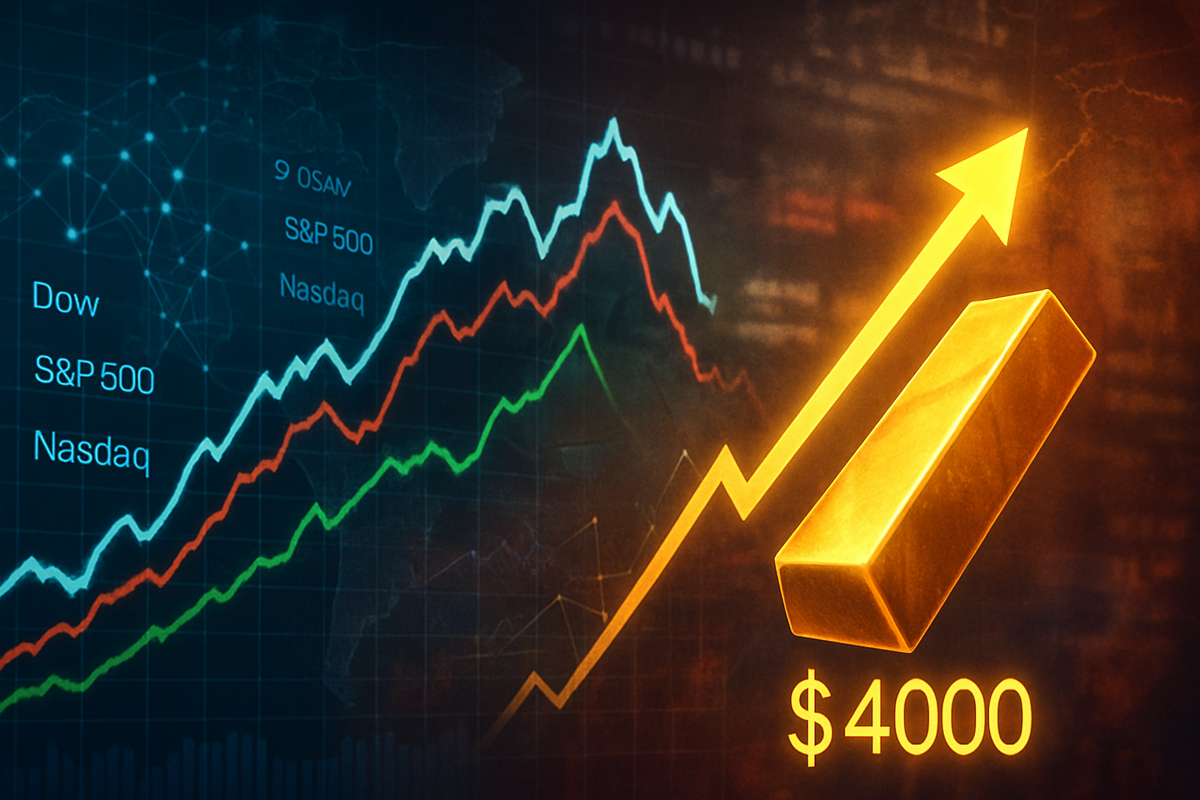
October 7, 2025 – The financial markets are navigating a complex and often contradictory landscape as major U.S. stock indices, including the S&P 500 and Nasdaq Composite, have shown signs of a slight retreat after notching new record highs. Simultaneously, the price of gold has surged past the unprecedented $4,000 per ounce mark, signaling an unusual "Everything rally" where both risk assets and safe havens are in high demand. This peculiar market dynamic reflects a delicate balance of investor optimism fueled by technological advancements and deep-seated anxieties stemming from geopolitical instability and domestic policy gridlock.
The concurrent movements—a momentary pause in the relentless climb of equities and a historic surge in gold—underscore a period of heightened uncertainty. Investors are grappling with the implications of an ongoing U.S. government shutdown, the Federal Reserve's dovish monetary stance, and fresh geopolitical tremors, all while a robust artificial intelligence (AI) boom continues to propel specific sectors of the stock market. The current environment suggests a market caught between the allure of growth and the imperative of capital preservation.
A Precarious Peak: Indices Slip as Gold Shines
The first week of October 2025 has been marked by a series of significant, albeit contrasting, market milestones. On Monday, October 6, 2025, the S&P 500 (SPX) and Nasdaq Composite (NDAQ) closed at fresh record highs, with the S&P 500 advancing 0.36% to 6,740.28 and the Nasdaq climbing 0.7% (161.81 points) to 22,941.67. This upward momentum, particularly in tech-heavy indices, was largely fueled by renewed enthusiasm for artificial intelligence, spurred by a multi-billion-dollar chip deal between Advanced Micro Devices (NASDAQ: AMD) and OpenAI. However, the Dow Jones Industrial Average (DJIA) bucked the trend on Monday, experiencing a slight decline of 0.1% (63.31 points) to 46,694.97, ending its six-session rally.
As Tuesday, October 7, dawned, the initial market sentiment shifted slightly, with U.S. stock futures indicating a modest pullback from these record levels. Dow futures were down 0.2% (81 points), S&P 500 futures edged lower by 0.1% (4 points), and Nasdaq futures traded nearly flat or fractionally lower (down 0.18%). This foreshadowed a retreat in major stock indexes during Tuesday's trading, where the Nasdaq and S&P 500 were down 0.6% and 0.4% respectively, and the Dow declined 0.2%. This cautious reaction came despite the continued strong performance of individual AI-related stocks, suggesting broader macroeconomic concerns were weighing on the overall market.
In stark contrast to the equity market's slight hesitation, gold prices achieved an unprecedented milestone. Spot gold surged past $4,000 per ounce for the first time late on Monday, October 6, and continued to trade above this threshold on Tuesday morning, October 7, 2025. This historic rally marks an almost 50% increase in gold prices since the beginning of 2025, positioning it for its best year since 1979. The demand for gold as a safe-haven asset has been significantly bolstered by a confluence of factors, including the ongoing U.S. government shutdown, expectations of further interest rate cuts by the U.S. Federal Reserve, and mounting geopolitical instability, particularly political turmoil in France and a weak yen in Japan. The Fed's September 2025 rate cut and the high probability (98%) of another 25-basis-point cut in October have weakened the dollar, making non-yielding assets like gold more attractive and contributing to what analysts describe as an "Everything rally"—a phenomenon driven by massive global liquidity and dovish monetary policies.
Corporate Fortunes in a Dual-Track Market
The current market environment, characterized by both an AI-driven tech boom and a flight to safe havens, presents a mixed bag for public companies, creating distinct winners and losers.
On the winning side, companies deeply entrenched in the artificial intelligence ecosystem are experiencing significant tailwinds. Semiconductor manufacturers like Advanced Micro Devices (NASDAQ: AMD) are prime examples, having seen their shares jump nearly 24% on Monday, October 6, following a major deal with OpenAI. This surge indicates robust demand for high-performance computing components essential for AI development. Other semiconductor giants (e.g., NVIDIA (NASDAQ: NVDA)), cloud computing providers (e.g., Microsoft (NASDAQ: MSFT), Amazon (NASDAQ: AMZN) AWS), and software companies developing AI applications are likely to continue benefiting from this trend, attracting investor capital even as broader market indices show caution. Their growth trajectories appear decoupled from some of the macroeconomic headwinds.
Conversely, the surge in gold prices to over $4,000 per ounce directly benefits gold mining companies and related industries. Miners such as Barrick Gold Corporation (NYSE: GOLD) and Newmont Corporation (NYSE: NEM) are poised to see enhanced profitability as their primary commodity commands record prices. This provides a strong incentive for increased exploration and production, potentially leading to higher dividends or share buybacks, making them attractive to investors seeking exposure to safe-haven assets. Furthermore, companies that hold significant gold reserves or offer gold-backed investment products could also see their valuations improve.
However, not all companies are positioned to thrive in this dual-track market. Companies that are highly sensitive to economic uncertainty, such as those in discretionary consumer goods, hospitality, or certain manufacturing sectors, could face headwinds. A prolonged U.S. government shutdown, for instance, could dampen consumer confidence and spending, directly impacting retail and service-oriented businesses. Additionally, companies heavily reliant on stable global trade or those with significant exposure to regions experiencing geopolitical instability might see disruptions to their supply chains and demand. The slight pullback in broader indices, even if minor, suggests that investors are becoming more selective, potentially rotating out of companies with weaker fundamentals or less clear growth narratives in favor of either robust tech plays or defensive assets.
Wider Implications: A New Era of Market Dynamics
The current market scenario, where major stock indices flirt with records while gold hits unprecedented highs, signifies a deeper shift in global financial dynamics. This "Everything rally" is not merely a fleeting anomaly but rather an indicator of profound underlying trends. Firstly, it highlights the immense liquidity injected into the global financial system by central banks, particularly the U.S. Federal Reserve, through successive quantitative easing measures and a continued dovish stance on interest rates. This abundance of capital, coupled with a weakening U.S. dollar, pushes investors to seek returns across a wide spectrum of assets, including both traditional growth stocks and safe havens.
Secondly, the event underscores the growing bifurcation of the equity market. The AI boom is not just a sector-specific rally; it represents a transformational technological wave that is fundamentally reshaping industries and driving exceptional growth in a select group of companies. This trend suggests that while broad market indices might experience volatility due to macroeconomic factors, companies at the forefront of technological innovation, particularly in AI, could continue to command premium valuations and attract significant investment flows, potentially leading to a more concentrated market leadership.
Moreover, the persistent demand for gold reflects an escalating level of systemic risk perceived by investors. The ongoing U.S. government shutdown, now in its second week, is not just a domestic political issue; it casts a shadow over the reliability of U.S. economic data and policy stability, fostering global uncertainty. Coupled with political turmoil in France and concerns over Japan's weak yen, these geopolitical developments reinforce gold's role as the ultimate safe haven. This situation could have ripple effects on global currency markets, potentially leading to further dollar weakness and increased volatility in other commodity prices. Regulatory bodies might also face pressure to address the implications of prolonged government shutdowns on market transparency and investor confidence. Historically, periods of such dual asset rallies have often preceded significant economic shifts, prompting comparisons to times of high inflation or geopolitical tension, where investors sought both growth and protection.
Navigating the Road Ahead: Opportunities and Challenges
Looking ahead, the financial markets are poised for continued volatility as investors attempt to reconcile the conflicting signals emanating from the equity and gold markets. In the short term, the resolution of the U.S. government shutdown will be a critical determinant of market sentiment. A swift resolution could alleviate some of the immediate uncertainty, potentially leading to a temporary pullback in gold prices and a renewed focus on corporate fundamentals for equities. Conversely, a prolonged shutdown could further exacerbate market jitters, intensifying the flight to safety and putting more pressure on risk assets. The Federal Reserve's upcoming monetary policy decisions, particularly the highly anticipated October rate cut, will also play a pivotal role in shaping investor expectations and asset valuations.
In the long term, the trajectory of the artificial intelligence revolution will remain a dominant theme. Companies that successfully integrate AI into their operations or develop groundbreaking AI technologies are likely to continue outperforming. This presents both opportunities for strategic investment in leading-edge tech firms and challenges for companies that fail to adapt, risking obsolescence. Investors should anticipate continued market opportunities in sectors benefiting from technological disruption and, conversely, challenges for those susceptible to economic slowdowns or geopolitical shocks. Potential strategic pivots for businesses might include diversifying supply chains, increasing digital transformation efforts, and hedging against currency fluctuations.
Several scenarios could unfold. A "soft landing" scenario, where inflation is tamed without a significant economic downturn, combined with continued AI-driven growth, could see equities resume their upward trajectory while gold stabilizes at elevated levels. Alternatively, a more severe economic contraction, possibly triggered by an unresolved government shutdown or intensified geopolitical crises, could lead to a deeper market correction in equities and further spikes in gold. The "Everything rally" might evolve, with either risk assets or safe havens eventually dominating, depending on which set of underlying drivers gains ascendancy. Market participants will need to remain agile, adapting their portfolios to evolving macroeconomic conditions and technological advancements.
A Market in Transition: Key Takeaways for Investors
The recent market movements—major indices slipping after record highs while gold breaches the $4,000 mark—paint a picture of a financial landscape in significant transition. The key takeaway is the emergence of a dual-track market, driven by both the undeniable power of technological innovation, particularly in artificial intelligence, and a pervasive undercurrent of global uncertainty. This creates a challenging yet potentially rewarding environment for investors, demanding a nuanced approach to portfolio management.
Moving forward, the market's trajectory will largely depend on the interplay of several critical factors: the resolution of the U.S. government shutdown, the Federal Reserve's future monetary policy decisions, and the ongoing evolution of geopolitical stability. Investors should assess the market with a keen eye on these macroeconomic indicators, as they will dictate the broader sentiment and capital flows. The "Everything rally" phenomenon, while unusual, highlights the current abundance of global liquidity and the complex motivations driving investment decisions—balancing the pursuit of growth with the imperative of capital preservation.
The lasting impact of this period could be a recalibration of traditional market correlations, where the inverse relationship between risk assets and safe havens becomes less predictable. What investors should watch for in the coming months includes any signs of de-escalation in global political tensions, clarity on the Fed's long-term interest rate strategy, and the continued earnings performance of AI-centric companies. Diversification, strategic allocation to both growth and defensive assets, and a vigilant monitoring of policy developments will be paramount for navigating this dynamic and uncertain market environment.
This content is intended for informational purposes only and is not financial advice.





